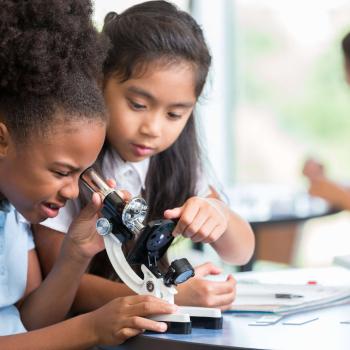Engaging Students in a Collaborative Exploration of the Gettysburg Address

- Preview |
- Standards |
- Resources & Preparation |
- Instructional Plan |
- Related Resources |
- Comments
Overview
This lesson plan invites students to learn more about the historical significance of President Abraham Lincoln's famous speech, the Gettysburg Address, as well as the time period and people involved. After reading the Gettysburg Address in its entirety, students work in small groups to closely examine one sentence from the speech. They conduct research to learn more about the Civil War and the context and significance of Lincoln's speech. Using an online tool, students create a multigenre project consisting of three types of writing and a drawing to communicate what they have discovered about the meaning and significance of their assigned sentence from the speech. The class then creates a display of the Gettysburg Address, with students' multigenre projects posted near the applicable lines. Finally, students use the class-created display as a resource for individual writing in which they paraphrase the Gettysburg Address, giving the main points.
Featured Resources
The Gettysburg Address: This U.S. government site features images of the Nicolay draft of the Address, historical background information, and a transcription of the text.
Multigenre Mapper: Students can use this online tool to create multigenre, multimodal texts, including three types of writing and a drawing, in response to the Gettysburg Address.
From Theory to Practice
Reading comprehension is often linked to understanding. However there is more to comprehending than simply "getting" what you read. In his article from Voices from the Middle, Robert Probst takes a look at his own comprehension and the strategies he uses while reading. He concludes, "Comprehension is too complex to be effectively assessed with anything so simple and reductive as a test, and it isn't achieved by concentrating solely on the text itself, though of course that does require close attention. Instead, to comprehend requires a concerted effort to see through the text to what lies beyond. And that demands an imaginative and committed reader." To achieve this kind of reading, students need the opportunity to examine texts closely and explore the underlying significance. This lesson asks students to do just that by closely examining the text of the Gettysburg Address and exploring its historical context and significance.
Further Reading
Common Core Standards
This resource has been aligned to the Common Core State Standards for states in which they have been adopted. If a state does not appear in the drop-down, CCSS alignments are forthcoming.
State Standards
This lesson has been aligned to standards in the following states. If a state does not appear in the drop-down, standard alignments are not currently available for that state.
NCTE/IRA National Standards for the English Language Arts
- 1. Students read a wide range of print and nonprint texts to build an understanding of texts, of themselves, and of the cultures of the United States and the world; to acquire new information; to respond to the needs and demands of society and the workplace; and for personal fulfillment. Among these texts are fiction and nonfiction, classic and contemporary works.
- 2. Students read a wide range of literature from many periods in many genres to build an understanding of the many dimensions (e.g., philosophical, ethical, aesthetic) of human experience.
- 3. Students apply a wide range of strategies to comprehend, interpret, evaluate, and appreciate texts. They draw on their prior experience, their interactions with other readers and writers, their knowledge of word meaning and of other texts, their word identification strategies, and their understanding of textual features (e.g., sound-letter correspondence, sentence structure, context, graphics).
- 4. Students adjust their use of spoken, written, and visual language (e.g., conventions, style, vocabulary) to communicate effectively with a variety of audiences and for different purposes.
- 5. Students employ a wide range of strategies as they write and use different writing process elements appropriately to communicate with different audiences for a variety of purposes.
- 6. Students apply knowledge of language structure, language conventions (e.g., spelling and punctuation), media techniques, figurative language, and genre to create, critique, and discuss print and nonprint texts.
- 7. Students conduct research on issues and interests by generating ideas and questions, and by posing problems. They gather, evaluate, and synthesize data from a variety of sources (e.g., print and nonprint texts, artifacts, people) to communicate their discoveries in ways that suit their purpose and audience.
- 8. Students use a variety of technological and information resources (e.g., libraries, databases, computer networks, video) to gather and synthesize information and to create and communicate knowledge.
- 11. Students participate as knowledgeable, reflective, creative, and critical members of a variety of literacy communities.
- 12. Students use spoken, written, and visual language to accomplish their own purposes (e.g., for learning, enjoyment, persuasion, and the exchange of information).
Materials and Technology
- Variety of Civil War and Gettysburg Address resources, including Websites and books
- Writing Notebooks or Journals
- LCD projector (optional)
Printouts
- Multigenre Mapper Planning Sheet
- Example of a completed multigenre mapper project
- Rubric
Websites
Preparation
- Assign students to be in groups, or allow time for them to select their own groups.
- Make copies of the Gettysburg Address. Highlight one sentence on each copy so that each group has one sentence to look at, read, and learn more about.
- Rewrite the Gettysburg Address on chart paper or on the board, so it is large, or use a poster if one is available.
- Test the Multigenre Mapper on your computers to familiarize yourself with the tools and ensure that you have the Flash plug-in installed. You can download the plug-in from the technical support page.
Student Objectives
Students will
- explore the history and meaning of the Gettysburg Address.
- define critical words and phrases in the Gettysburg Address.
- make connections between the Address and other resources related to the topic.
- demonstrate understanding of this speech by creating a written and visual project to guide their discussion.
- work individually and in cooperative groups.
- present their group graphic to the whole class as a way of sharing their section and connecting their graphical representation to the text.
- write a summary of the Gettysburg Address in their own words.
Session One
- Begin by asking the students what they know about the Civil War. They can share when it occurred, why it took place, what the outcome was, who was involved, and other details that they know.
- Ask students if they know of anything that became famous as a result of the Civil War. Hopefully someone will volunteer the answer, “Gettysburg Address.”
- Invite the students to share what they know about the Gettysburg Address. Take notes on the board or on chart paper, if desired.
- Explain that four months after the Battle of Gettysburg, President Abraham Lincoln was invited to participate in the dedication ceremony for a cemetery that had been established on the land where the battle took place. Lincoln’s role in this ceremony was not as the primary speaker, but his speech was an important event in the ceremony and in the nation.
- Read the Gettysburg Address aloud to the group. Allow time for the students to comment about what was read.
- Explain to students that in the next session, they will be working in groups to learn more about what was said in the Gettysburg Address as well as to find out more about the time period and the people involved.
- To end the session, share some of the selected books from the booklist, and allow the remaining time for students to read and explore.
Session Two
- Introduce students to the Multigenre Mapper and explain how students will use each of the areas of the tool. Use an LCD projector, if available.
- After entering the title of the project, “The Gettysburg Address” and their names into the Multigenre Mapper, students should fill in the rest of the blanks as follows:
- In Section A, students should type in “Text From the Gettysburg Address.” In the related space, students will type in their sentence as it was written in the Gettysburg Address.
- In Section B, students should label it, “Key Words and Phrases.” In this space, students will note vocabulary words or meaningful phrases they want to learn more about.
- In Section C, the label should be “Significance.” This is the section where students write what they have learned about their sentence from the Gettysburg Address.
- When their writing is done, students illustrate their page, using the drawing tools in the Multigenre Mapper. These illustrations can include drawings, shapes, symbols, colors that remind you of things from the Gettysburg Address.
- In Section A, students should type in “Text From the Gettysburg Address.” In the related space, students will type in their sentence as it was written in the Gettysburg Address.
- Share the example printout from the Multigenre Mapper to help students visualize the project.
- Have the students get into their groups. Since each group will be working on one sentence of the Gettysburg Address, pass out a copy of the Gettysburg Address with the sentences highlighted.
- Invite students to read the entire Gettysburg Address several times to themselves as well as read it in their group.
- After several readings, ask students to read their highlighted sentence aloud within their group. They should now have some understanding of this sentence in context.
- Using the gathered resources, including books, Websites, and other reference materials, invite the students to learn more about their section of the Gettysburg Address.
- Students can use the Multigenre Mapper Planning Sheet as they are taking notes and planning their project.
- When students have compiled all of the information that they need, have them use the Multigenre Mapper to publish their information.
- While students are working, float around the room, listening to the discussions and answering questions as needed.
Session Three
- When all of the groups have completed their Multigenre Mapper projects, invite groups to share what they learned about their sentence of the Gettysburg Address.
- Display the large version of the Gettysburg Address, on chart paper or a poster.
- After groups share what is on their Multigenre Mapper projects, ask them to hang them next to the related place by the chart paper or poster.
- Allow time for questions, if the students or groups have any.
- As the students and groups present their portion of the Gettysburg Address, assess their work using the rubric.
Session Four
- After all of the groups have shared their piece from the Gettysburg Address, ask students to get out their writing notebooks or journals.
- In their notebooks or journals, ask students to paraphrase the Gettysburg Address, giving the main points.
- Remind them that they can use the Multigenre Mapper projects as resources while completing this project.
- Ask for volunteers to share their summary of the Gettysburg Address.
Extensions
- As a class, construct a timeline that puts the Battle of Gettysburg into historical context with other major events of the era.
- Students can create a map of Gettysburg and the location where the speech took place.
- Extend your study of the Gettysburg Address using the resources available in the ReadWriteThink calendar entry marking Abraham Lincoln's famous speech.
Student Assessment / Reflections
Observe participation during students’ exploration and discussion of the Gettysburg Address, as well as while students use reference materials as a part of their research. Monitor students’ progress and process as they conduct their research about their selected topics. As students present their published research to the class, take notes and assess their work using the rubric.
Students’ summaries of the Gettysburg Address can also be collected, and reviewed for indications of their comprehension of the document.

Add new comment